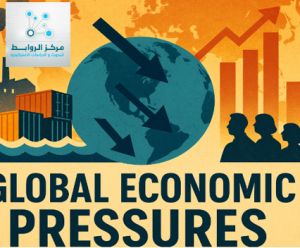Despite escalating geopolitical tensions, rising trade barriers, and persistent financial market uncertainty, the global economy has demonstrated stronger-than-expected resilience. Projections indicate that world GDP growth will reach approximately 3.1 percent in 2025, before slightly declining to 2.9 percent in 2026. A significant factor behind this stability is increased investment in emerging technologies, particularly artificial intelligence, which has helped offset weaker consumer spending and tighter monetary policies.
In the United States, economic momentum remains relatively steady. However, new tariffs and restrictions on international trade have begun to erode purchasing power and drive up consumer prices. Business confidence has been supported by robust investments in software, research and development, and digital infrastructure linked to AI advancements. Rising stock prices have also helped sustain household expenditure levels. On the downside, reduced migration rates have slowed job growth, and tariffs are expected to contribute to a modest uptick in inflation through 2026. U.S. GDP growth is anticipated to gradually decelerate, with the Federal Reserve likely to lower interest rates to maintain labor market stability.
Globally, economic performance varies significantly across regions. In the eurozone, growth remains uneven. Southern European countries continue to perform strongly, driven by tourism and public investment, while Northern Europe faces slowdowns due to weak industrial output and declining exports. In Japan, fresh fiscal stimulus is expected to provide a temporary boost to economic activity, though inflationary pressures may dampen its long-term impact. The United Kingdom continues to experience sluggish growth, hindered by low productivity and the adverse effects of a strong domestic currency on export competitiveness.
Among major emerging economies, India leads in terms of expansion. Strong domestic investment and resilient consumer spending are key drivers of its economic trajectory. China, by contrast, faces a more fragile situation. While exports remain stable, the ongoing real estate sector crisis continues to undermine consumer confidence and suppress internal demand. In Brazil, high interest rates have constrained economic activity. Russia’s economy remains constrained by international financial sanctions and lower oil prices, limiting its capacity to expand production and trade.
Why is a slowdown expected in 2026?
The projected deceleration in 2026 stems from the growing impact of trade barriers, tighter global monetary conditions, and uncertainty over how quickly AI-related investments will translate into tangible productivity gains. If business sentiment weakens or the anticipated benefits of artificial intelligence fail to materialize at the expected pace, the negative consequences of tariffs and weakening global demand could become more pronounced. This suggests that while current economic resilience is real, it remains fragile.
In conclusion, the global economy is navigating a complex landscape marked by both opportunities and risks. Technological innovation offers new pathways for growth, but trade tensions, inflationary pressures, and structural challenges in several regions continue to shape the economic outlook. Sustainable growth will depend on nations’ ability to maintain macroeconomic stability, foster innovation-driven investment, and address underlying issues such as labor shortages, inequality, and fragmentation in global supply chains.
— news from (مركز الروابط للدراسات الاستراتيجية والسياسية)
— News Original —
النمو الاقتصادي العالمي تحت الضغط: كيف تعيد التوترات التجارية والاختلافات الإقليمية تشكيل الاقتصاد الدولي – مركز الروابط للدراسات الاستراتيجية والسياسية
الباحثة شذا خليل* n nعلى الرغم من تصاعد التوترات الجيوسياسية وارتفاع الحواجز التجارية وعدم اليقين المستمر في الأسواق المالية، يظهر الاقتصاد العالمي قدرة أعلى من المتوقع على الصمود. حيث يُتوقع أن يبلغ نمو الناتج المحلي الإجمالي العالمي حوالي 3.1 بالمئة في عام 2025 لينخفض قليلاً إلى 2.9 بالمئة في عام 2026. ويعود جزء كبير من هذا الاستقرار إلى زيادة الاستثمارات في التقنيات الجديدة، خاصة الذكاء الاصطناعي، الذي ساعد على تعويض التباطؤ في إنفاق المستهلكين وتشديد السياسات الاقتصادية. n nفي الولايات المتحدة، لا يزال الزخم الاقتصادي مستقراً إلى حد ما، على الرغم من أن الرسوم الجمركية الجديدة والقيود على التجارة الدولية بدأت تقلل من القوة الشرائية وترفع أسعار السلع. وقد ساهم الاستثمار في البرمجيات والبحث والتطوير والتقنيات الرقمية المرتبطة بالذكاء الاصطناعي في تعزيز ثقة الشركات. كما ساعد ارتفاع أسعار الأسهم في الحفاظ على مستويات إنفاق الأسر. ومع ذلك، فإن انخفاض معدلات الهجرة أدى إلى تباطؤ نمو الوظائف، ويتوقع أن تؤدي الرسوم الجمركية إلى ارتفاع بسيط في معدلات التضخم حتى عام 2026. ومن المتوقع أن يتباطأ نمو الناتج المحلي الإجمالي الأمريكي بشكل تدريجي، بينما يعمل مجلس الاحتياطي الفيدرالي على خفض أسعار الفائدة للحفاظ على استقرار سوق العمل. n nعلى المستوى العالمي، تختلف مؤشرات الأداء الاقتصادي بشكل واضح بين المناطق. ففي منطقة اليورو، لا يزال النمو متفاوتاً. حيث تحافظ دول جنوب أوروبا على أداء قوي بفضل السياحة والاستثمارات العامة، بينما تواجه دول شمال أوروبا تباطؤاً نتيجة ضعف قطاع الصناعة والصادرات. وفي اليابان، من المتوقع أن تعطي الحوافز المالية الجديدة دفعة مؤقتة للنمو، ولكن من المحتمل أن يتراجع هذا التأثير مع ارتفاع الأسعار. أما في المملكة المتحدة، فلا يزال النمو ضعيفاً بسبب انخفاض الإنتاجية وتأثير قوة العملة المحلية على الصادرات. n nأما الاقتصادات الناشئة الكبرى، فتتصدرها الهند باعتبارها الأسرع نمواً. حيث يدعم ارتفاع الاستثمارات المحلية والإنفاق الاستهلاكي نموها الاقتصادي. بينما تواجه الصين وضعاً أكثر حساسية. فالصادرات مستقرة، لكن الأزمة المستمرة في قطاع العقارات تضعف ثقة المستهلك وتقلل الطلب المحلي. وفي البرازيل، أدى ارتفاع أسعار الفائدة إلى إبطاء النشاط الاقتصادي. أما روسيا، فلا يزال اقتصادها مقيداً بالعقوبات المالية وانخفاض أسعار النفط، مما يحد من قدرتها على تعزيز الإنتاج والتجارة. n nلماذا يتوقع تباطؤ النمو في عام 2026؟ n nيُعزى التباطؤ المتوقع في 2026 إلى زيادة تأثير الحواجز التجارية، وتشديد السياسات المالية العالمية، وعدم اليقين حول مدى سرعة تحول الاستثمارات في الذكاء الاصطناعي إلى مكاسب إنتاجية ملموسة. وإذا تراجعت ثقة الشركات أو لم تتحقق فوائد الذكاء الاصطناعي بالسرعة المتوقعة، فقد تظهر الآثار السلبية للرسوم الجمركية وتباطؤ الطلب العالمي بشكل أوضح. مما يشير إلى أن متانة الاقتصاد الحالية حقيقية لكنها هشة. n nختاما يمر الاقتصاد العالمي بمرحلة تجمع بين الفرص والمخاطر. فالابتكار التكنولوجي يوفر مصادر جديدة للنمو، لكن التوترات التجارية وضغوط التضخم والتحديات الهيكلية في بعض المناطق لا تزال تؤثر على المشهد الاقتصادي. وسيعتمد تحقيق نمو مستدام على قدرة الدول على الحفاظ على الاستقرار الاقتصادي، ودعم الاستثمار في الابتكار، ومعالجة التحديات الأساسية مثل نقص العمالة وعدم المساواة وتجزؤ سلاسل الإمداد العالمية.
